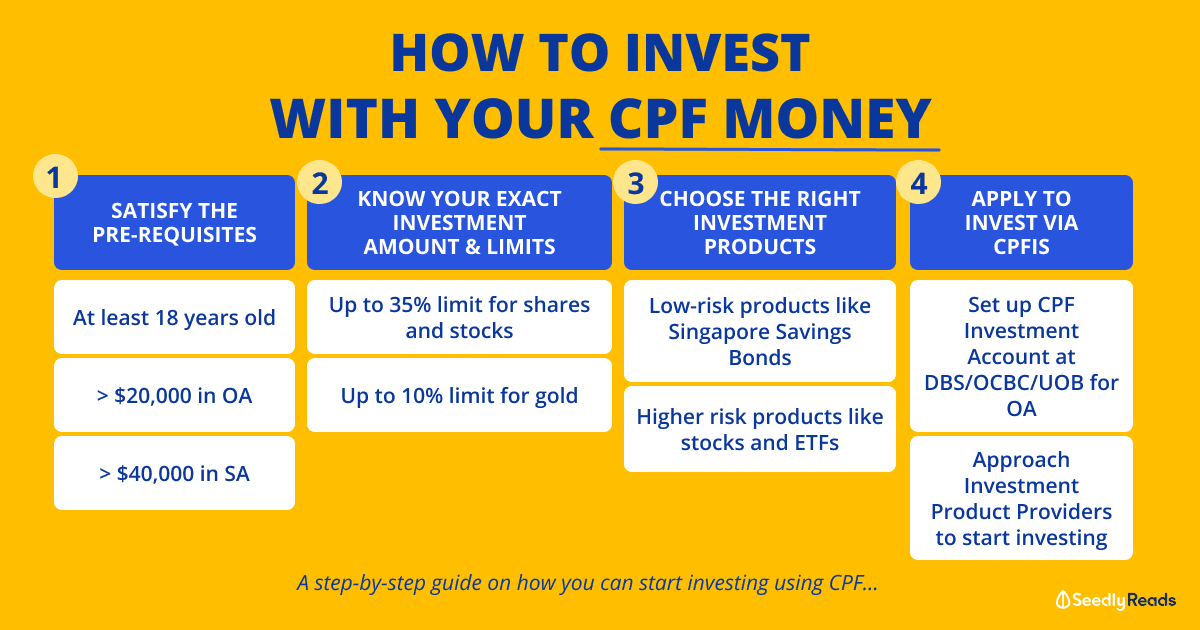How much do you know about the CPF Scheme?
Known to be both massive and complicated, the Central Provident Fund (CPF) Scheme is not easily understood by many.
Especially for Singaporeans who’ve just embarked on your #adulting life, you probably have no clue what you should know about CPF.
For working adults and those approaching retirement, you should already have a substantial amount of funds in your CPF account.
PSA: Rather than let your money stay stagnant in your CPF fund, did you know that you have the option to use your money for investments?
Huh? CPF Can Invest One Ah?

Yes!
For those who didn’t know, you can invest in a wide range of investment products using your Ordinary Account (OA) and Special Account (SA) savings under the CPF Investment Scheme (CPFIS).
But, if you think you can skirt around the system and happily spend your investment earnings with the CPFIS, you’ll be sorely disappointed.
Do note that any returns from the investments that you make will go back to your CPF accounts.
That means that you can only withdraw the earnings from your investment after the age of 55.
Of course, as with all other investments, you must know what you’re getting yourself into before actually throwing your money into them!
Who Can Invest With Their CPF Money?
Huat ah! You can invest under CPFIS, if you:
- are at least 18 years old;
- are not an undischarged bankrupt;
- have more than $20,000 in your OA; and/or
- have more than $40,000 in your SA
That’s actually a whole lot of cash stashed away in your OA and SA, before you can start investing with CPF.
Furthermore, so that the government knows that you’re capable of handling your own money, you will need to take a Self-Awareness Questionnaire (SAQ) before you can start investing!
TL;DR: A Step-By-Step Guide On How To Invest Using CPF

Step 1: Satisfy the above prerequisites
- You will have to set aside ($$$ cannot be touched) $20,000 in your OA and/or $40,000 in your SA. The rest of the money that’s left is called “Investible Savings”. You can use those for investing!
Step 2: Know your limits, and exactly how much money you have to invest.
- Because our government loves helping us protect our money, there is a limit cap to how much you can invest in certain products. With your Ordinary Account, you have the following restrictions:
- You can only invest up to 35% in stocks
- You can only invest up to 10% of your money in gold.
- Everyone has a different amount of dough in their CPF. To find out exactly how much you have:
- Login to CPF website, or the myCPF app using your SingPass. mycpf Online Services –> My Statement
- Visit any CPF Service Centres with your identity card.
Step 3: Know what investment products you can invest in
- Letting your money sit in your CPF earns you the following current CPF interest rates (i/r):
| Account Type | Annual Interest Rates |
|---|---|
| Ordinary Account (OA) | 2.5% (up to 3.5%) |
| Special Account (SA) | 4% (up to 5%) |
| Medisave Account (MA) | 4% (up to 5%) |
| Retirement Account (RA) | 4% (up to 5%) |
* An extra1% bonus interest rate is given on first $60,000 (capped at $20,000 for OA).
* For those 55 years an up, extra 1% interest rate on first $30,000 (capped at $20,000 for OA)
So if you want to invest, make sure that:
- You invest in investment products that give you an interest rate that is equivalent to, or better than the rates given by CPF Board
- You should invest in investment products that suit your risk appetite. There are some financial products that are riskier than others, so do remember to exercise the right judgement before investing in those products!
You can use your CPF savings to invest in the following investment products
| Type of investment | Invest using Ordinary Account (OA) | Invest using Savings Account (SA) |
|---|---|---|
| Singapore Government Bonds | Yes | Yes |
| Annuities | Yes | Yes |
| Treasury Bills | Yes | Yes |
| Endowment policies | Yes | Yes |
| ETFs | Yes | Yes, excluding high-risk ETFs |
| Unit trusts | Yes | Yes, excluding high-risk Unit Trusts |
| Investment-linked insurance products | Yes | Yes, excluding high-risk Insurance Products |
| Fund management accounts | Yes | No |
| Selected retail bonds | Up to 35% of investible savings | No |
| Shares | Up to 35% limit of investible savings | No |
| Property funds | Up to 35% limit of investible savings | No |
| Gold ETFs | Up to 10% limit of investible savings | No |
| Other gold products | Up to 10% limit of investible savings | No |
Step 4: Apply to invest your CPF savings via CPFIS
| Type of CPFIS | Procedure |
|---|---|
| CPFIS-OA | Open a CPF Investment Account with DBS, OCBC, or UOB. |
| CPFIS-SA | No need to open a CPF Investment Account. |
Thereafter, you can approach the product providers directly to buy or sell your investments.
If you want to use your CPF Ordinary Account to invest, you’ll have to open a CPF Investment Account with DBS, OCBC or UOB. Fees and charges for opening an account with all 3 banks are generally the same, so it doesn’t matter which bank you open your account with to administer the funds.
If this is your first time investing, you will still need a brokerage account to actually invest the money.
An example of how this works:
- You open a CPF Investment Account with OCBC, and choose to buy a stock from Singtel.
- Singtel will liaise with OCBC to execute the purchase.
See? So simple.
If you want to use your CPF Special Account to invest, you can just approach the investment product providers directly. These include fund management companies or investment administrators.
Investing With Your CPF $$$
Alternatively, for those of you who are earning more than $40,000 per year and can spare the extra cash, you can also consider investing with Supplementary Retirement Scheme (SRS)
Opening an SRS Account and investing through SRS can give higher returns (for selected financial products) and tax relief. Note that opening the account alone will not give you a significant increase in additional interest rates.
Contrary to popular belief, the money you put in your CPF isn’t just locked up until your retirement.
You can always opt to use a portion of it out to invest for higher returns.
Of course, that’s not forgetting the risk involved when investing in more volatile financial products.
Would you invest your CPF monies? Let us know at Seedly!
Advertisement

